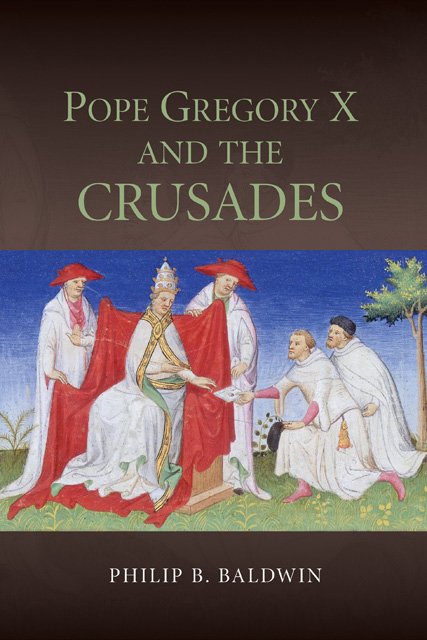Book contents
- Frontmatter
- Dedication
- Contents
- Acknowledgements
- Abbreviations
- Introduction
- 1 The Early Life of Pope Gregory X
- 2 ‘We Saw with Our Eyes and Felt with Our Very Own Hand’: The Importance of Understanding the Condition of the Holy Land
- 3 Interim Crusade Planning
- 4 A Problem of Governance? Pope Gregory X, Charles of Anjou, and the Latin Kingdom of Jerusalem
- 5 Political Exigencies and Gregory’s Crusade
- 6 Imagining Gregory’s Crusade
- Conclusion
- Bibliography
- Index
- Other Volumes in Studies in the History of Medieval Religion
6 - Imagining Gregory’s Crusade
Published online by Cambridge University Press: 28 February 2023
- Frontmatter
- Dedication
- Contents
- Acknowledgements
- Abbreviations
- Introduction
- 1 The Early Life of Pope Gregory X
- 2 ‘We Saw with Our Eyes and Felt with Our Very Own Hand’: The Importance of Understanding the Condition of the Holy Land
- 3 Interim Crusade Planning
- 4 A Problem of Governance? Pope Gregory X, Charles of Anjou, and the Latin Kingdom of Jerusalem
- 5 Political Exigencies and Gregory’s Crusade
- 6 Imagining Gregory’s Crusade
- Conclusion
- Bibliography
- Index
- Other Volumes in Studies in the History of Medieval Religion
Summary
The Crusade that Never Was
Norman Housley has written that ‘the demise of any pope at such a critical point in crusade planning presents the historian with an insuperable problem of interpretation.’1 Interpreting Gregory’s crusade is especially interesting, since he was the last pope to come close to launching a major crusade to rescue the Holy Land. Gregory stands alone as the pope able to gain the participation of virtually all of Europe’s major rulers: Germany and the Empire, France, Sicily, Aragon, Portugal, Sweden, and (in a way) Castile.2 To this list, England and Bohemia could also potentially be added. The general recruitment for the crusade was also rigorously pursued from August 1274 onward with an extensive preaching campaign.3 Indulgences of 100 days could be granted to anyone who would come to listen to a crusade sermon and confess their sins.4 With the success of the ecclesiastical union at Lyons, Gregory even had Greek support for his crusade as well. With strong potential for an alliance with the Mongols, this crusade could have been staggeringly large. The fact that the crusade came to nothing after Gregory’s death need not prevent an analysis of its organisation and aims. An examination of Gregory’s plans for his general passage can demonstrate the changes the crusading movement was undergoing at the end of its classical period in the thirteenth century. This was not only in the dual crusade policy that Gregory adopted, but also in the direction of the general passage.
The Participation of Philip of France
King Philip III of France was supposed to be one of the cornerstones of Gregory’s crusade. All indications from Gregory’s dealings with Philip point to the pope’s desire for this. Gregory had been working more closely with Philip for the interim crusading preparations than with any other monarch, save for Charles of Anjou’s supply of food. Besides the Church itself, it was only Philip who had been making investments in mercenaries to defend the Holy Land. Thus, his interests there were at stake. Although James of Aragon was the first monarch to give Gregory a firm signal that he would take up the cross, it was Philip who actually first took up the cross, which he did at his wedding to Maria of Brabant on the feast of St John the Baptist, 24 June 1275.
- Type
- Chapter
- Information
- Pope Gregory X and the Crusades , pp. 168 - 220Publisher: Boydell & BrewerPrint publication year: 2014



